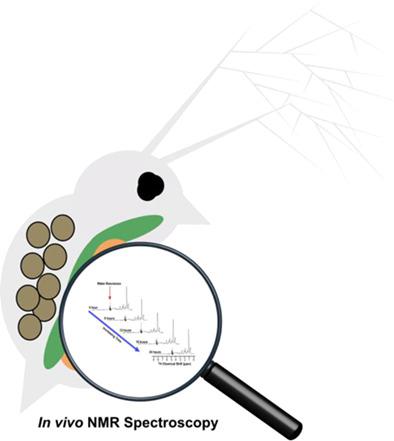当前位置:
X-MOL 学术
›
Magn. Reson. Chem.
›
论文详情
Our official English website, www.x-mol.net, welcomes your
feedback! (Note: you will need to create a separate account there.)
Flow-Based in vivo NMR spectroscopy of small aquatic organisms
Magnetic Resonance in Chemistry ( IF 1.9 ) Pub Date : 2019-07-11 , DOI: 10.1002/mrc.4886 Ronald Soong 1 , Yalda Liaghati Mobarhan 1 , Maryam Tabatabaei 1 , Monica Bastawrous 1 , Rajshree Ghosh Biswas 1, 2 , Myrna Simpson 1, 2 , Andre Simpson 1, 2
Magnetic Resonance in Chemistry ( IF 1.9 ) Pub Date : 2019-07-11 , DOI: 10.1002/mrc.4886 Ronald Soong 1 , Yalda Liaghati Mobarhan 1 , Maryam Tabatabaei 1 , Monica Bastawrous 1 , Rajshree Ghosh Biswas 1, 2 , Myrna Simpson 1, 2 , Andre Simpson 1, 2
Affiliation

|
NMR applied to living organisms is arguably the ultimate tool for understanding environmental stress responses and can provide desperately needed information on toxic mechanisms, synergistic effects, sublethal impacts, recovery, and biotransformation of xenobiotics. To perform in vivo NMR spectroscopy, a flow cell system is required to deliver oxygen and food to the organisms while maintaining optimal line shape for NMR spectroscopy. In this tutorial, two such flow cell systems and their constructions are discussed: (a) a single pump high‐volume flow cell design is simple to build and ideal for organisms that do not require feeding (i.e., eggs) and (b) a more advanced low‐volume double pump flow cell design that permits feeding, maintains optimal water height for water suppression, improves locking and shimming, and uses only a small recirculating volume, thus reducing the amount of xenobiotic required for testing. In addition, key experimental aspects including isotopic enrichment, water suppression, and 2D experiments for both 13C enriched and natural abundance organisms are discussed.
中文翻译:

基于流动的小型水生生物体内核磁共振波谱
应用于生物体的 NMR 可以说是了解环境压力反应的终极工具,可以提供迫切需要的关于毒性机制、协同效应、亚致死影响、恢复和外源生物转化的信息。为了执行体内 NMR 光谱,需要流动池系统向生物体输送氧气和食物,同时保持 NMR 光谱的最佳线形。在本教程中,将讨论两个这样的流通池系统及其结构:(a) 单泵大容量流通池设计易于构建,非常适合不需要喂养的生物体(即鸡蛋)和 (b)更先进的低容量双泵流通池设计,允许进料,保持最佳水位以抑制水,改善锁定和匀场,并且仅使用很小的再循环体积,从而减少了测试所需的异生物质的量。此外,还讨论了 13C 富集和天然丰度生物的关键实验方面,包括同位素富集、水抑制和 2D 实验。
更新日期:2019-07-11
中文翻译:

基于流动的小型水生生物体内核磁共振波谱
应用于生物体的 NMR 可以说是了解环境压力反应的终极工具,可以提供迫切需要的关于毒性机制、协同效应、亚致死影响、恢复和外源生物转化的信息。为了执行体内 NMR 光谱,需要流动池系统向生物体输送氧气和食物,同时保持 NMR 光谱的最佳线形。在本教程中,将讨论两个这样的流通池系统及其结构:(a) 单泵大容量流通池设计易于构建,非常适合不需要喂养的生物体(即鸡蛋)和 (b)更先进的低容量双泵流通池设计,允许进料,保持最佳水位以抑制水,改善锁定和匀场,并且仅使用很小的再循环体积,从而减少了测试所需的异生物质的量。此外,还讨论了 13C 富集和天然丰度生物的关键实验方面,包括同位素富集、水抑制和 2D 实验。











































 京公网安备 11010802027423号
京公网安备 11010802027423号